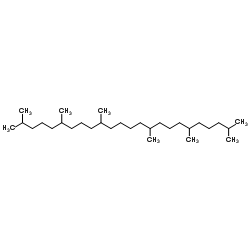Squalane

Squalane structure
|
Common Name | Squalane | ||
|---|---|---|---|---|
| CAS Number | 111-01-3 | Molecular Weight | 422.813 | |
| Density | 0.8±0.1 g/cm3 | Boiling Point | 470.3±0.0 °C at 760 mmHg | |
| Molecular Formula | C30H62 | Melting Point | −38 °C(lit.) | |
| MSDS | Chinese USA | Flash Point | 217.8±0.0 °C | |
|
Biological importance and applications of squalene and squalane.
Adv. Food Nutr. Res. 65 , 223-33, (2012) Squalene is a polyunsaturated hydrocarbon with a formula of C₃₀H₅₀. Squalene can be found in certain fish oils, especially shark liver oil, in high amounts and some vegetable oils in relatively smaller amounts. Human sebum also contains 13% squalene as one of... |
|
|
How membrane permeation is affected by donor delivery solvent.
Phys. Chem. Chem. Phys. 14(44) , 15525-38, (2012) We investigate theoretically and experimentally how the rate and extent of membrane permeation is affected by switching the donor delivery solvent from water to squalane for different permeants and membranes. In a model based on rate-limiting membrane diffusi... |
|
|
Effects of squalene/squalane on dopamine levels, antioxidant enzyme activity, and fatty acid composition in the striatum of Parkinson's disease mouse model.
J. Oleo Sci. 62(1) , 21-8, (2013) Active oxygen has been implicated in the pathogenesis of Parkinson's disease (PD); therefore, antioxidants have attracted attention as a potential way to prevent this disease. Squalene, a natural triterpene and an intermediate in the biosynthesis of cholester... |
|
|
Squalene emulsions for parenteral vaccine and drug delivery.
Molecules 14(9) , 3286-312, (2009) Squalene is a linear triterpene that is extensively utilized as a principal component of parenteral emulsions for drug and vaccine delivery. In this review, the chemical structure and sources of squalene are presented. Moreover, the physicochemical and biolog... |
|
|
Defensive effects of fullerene-C60 dissolved in squalane against the 2,4-nonadienal-induced cell injury in human skin keratinocytes HaCaT and wrinkle formation in 3D-human skin tissue model.
J. Biomed. Nanotechnol. 6(1) , 52-8, (2010) We dissolved fullerene-C60 in squalane (LipoFullerene; LF-SQ, C60-eq.: 500 ppm) and examined its defensive effects against 2,4-nonadienal (NDA)-induced cell injury in HaCaT keratinocytes and wrinkle formation in three dimensional (3D)-human skin tissue model.... |
|
|
Predicting the wetting dynamics of a two-liquid system.
Langmuir 27(24) , 14958-67, (2011) We propose a new theoretical model of dynamic wetting for systems comprising two immiscible liquids, in which one liquid displaces another from the surface of a solid. Such systems are important in many industrial processes and the natural world. The new mode... |
|
|
Phase behavior, formation, and rheology of cubic phase and related gel emulsion in Tween 80/water/oil systems.
J. Oleo Sci. 58(7) , 361-7, (2009) We investigated the phase behavior, formation, and rheology of the cubic phase (I(1)) and related O/I(1) gel emulsion in water/Tween 80/oil systems using squalane, liquid paraffin (LP), and decane as oil components. In the phase behavior study, the phase sequ... |
|
|
Modeling reactive scattering of F(2P) at a liquid squalane interface: a hybrid QM/MM molecular dynamics study.
J. Phys. Chem. A 113(26) , 7218-26, (2009) To better understand the reactivity of gases with liquid surfaces, experimentalists have recently probed the reactive scattering of atomic fluorine at the surface of liquid squalane (C(30)H(62)). In this paper we further this research by simulating this scatt... |
|
|
Effect of water on foaming properties of diglycerol fatty acid ester-oil systems.
Langmuir 23(13) , 6918-26, (2007) We have studied the effect of added water on the nonaqueous foaming properties of diglycerol fatty acid ester nonionic surfactant systems. Diglycerol monomyristate (designated as DGM) could not foam in nonpolar oils squalane and hexadecane at normal room temp... |
|
|
A stochastic, local mode study of neon-liquid surface collision dynamics.
Phys. Chem. Chem. Phys. 13(2) , 762-78, (2011) Equations of motion for a fast, light rare gas atom passing over a liquid surface are derived and used to infer the dynamics of neon collisions with squalane and perfluorinated polyether surfaces from experimental data. The equations incorporate the local mod... |